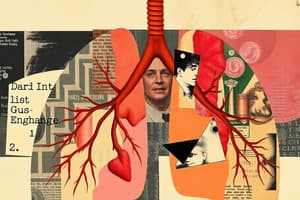Podcast
Questions and Answers
What is the primary function of the lungs?
What is the primary function of the lungs?
- Filtration of Blood
- Production of Hemoglobin
- Regulation of Body Temperature
- Exchange of Oxygen and Carbon Dioxide (correct)
What is the approximate concentration of oxygen in the atmosphere?
What is the approximate concentration of oxygen in the atmosphere?
21%
What is the pCO2 range in the body?
What is the pCO2 range in the body?
35 - 45
Diffusion of oxygen occurs from a tissue capillary into a __________.
Diffusion of oxygen occurs from a tissue capillary into a __________.
Hemoglobin is the most common way of transporting carbon dioxide.
Hemoglobin is the most common way of transporting carbon dioxide.
What does a right shift in the Oxyhemoglobin Dissociation Curve indicate?
What does a right shift in the Oxyhemoglobin Dissociation Curve indicate?
What is thoracentesis used for?
What is thoracentesis used for?
What is the normal tidal volume (VT) in milliliters?
What is the normal tidal volume (VT) in milliliters?
Match the compliance types with their definitions:
Match the compliance types with their definitions:
What is the normal ventilation/perfusion (V/Q) ratio?
What is the normal ventilation/perfusion (V/Q) ratio?
Intrapulmonary shunting refers to deoxygenated blood returning to the __________.
Intrapulmonary shunting refers to deoxygenated blood returning to the __________.
What is the primary function of the lungs?
What is the primary function of the lungs?
What is the normal concentration of Oxygen in the atmosphere?
What is the normal concentration of Oxygen in the atmosphere?
What is the most common way oxygen is transported in the body?
What is the most common way oxygen is transported in the body?
What does a leftward shift in the Oxyhemoglobin Dissociation Curve indicate?
What does a leftward shift in the Oxyhemoglobin Dissociation Curve indicate?
Exhaled Carbon Dioxide concentration is approximately 35-45 $mmHg$.
Exhaled Carbon Dioxide concentration is approximately 35-45 $mmHg$.
The volume of air exhaled during the relaxation phase of respiration is called ______.
The volume of air exhaled during the relaxation phase of respiration is called ______.
What is Dynamic Compliance?
What is Dynamic Compliance?
Match the following terms with their definitions:
Match the following terms with their definitions:
What is the normal V/Q ratio?
What is the normal V/Q ratio?
What is the primary function of the lungs?
What is the primary function of the lungs?
What is the approximate concentration of oxygen in the atmosphere?
What is the approximate concentration of oxygen in the atmosphere?
What occurs at the alveolar level?
What occurs at the alveolar level?
Match the following terms with their definitions regarding oxygen transportation:
Match the following terms with their definitions regarding oxygen transportation:
A shift to the right in the Oxyhemoglobin Dissociation Curve indicates a higher affinity of hemoglobin for oxygen.
A shift to the right in the Oxyhemoglobin Dissociation Curve indicates a higher affinity of hemoglobin for oxygen.
The __________ is a fiberoptic visualization procedure used for the bronchioles.
The __________ is a fiberoptic visualization procedure used for the bronchioles.
What is thoracentesis used for?
What is thoracentesis used for?
During which phase does tidal volume occur?
During which phase does tidal volume occur?
What is the normal vital capacity range?
What is the normal vital capacity range?
Dynamic compliance is measured when the lungs are at rest.
Dynamic compliance is measured when the lungs are at rest.
What does V/Q mismatch refer to?
What does V/Q mismatch refer to?
Hypoventilation results in increased __________.
Hypoventilation results in increased __________.
Flashcards are hidden until you start studying
Study Notes
Movement of O2 and CO2
- Lungs primarily function to exchange oxygen and carbon dioxide.
- Inhaled air contains approximately 21% oxygen, which is transferred to cells via arteries.
- Carbon dioxide (CO2), typically in the range of 35-45 mmHg, is exhaled after being transferred from body cells to lungs through veins.
- Gas exchange occurs at the alveolar level, where oxygen and CO2 diffusion takes place.
Oxygen Transportation
- Oxygen is transported in two main forms:
- Dissolved in plasma, measured as partial pressure of oxygen (PaO2).
- Bound to hemoglobin, which is the most common transportation method.
Oxyhemoglobin Dissociation Curve
- The curve illustrates the relationship between dissolved oxygen and hemoglobin-bound oxygen:
- A left shift indicates higher hemoglobin affinity for oxygen.
- A normal curve reflects typical hemoglobin function.
- A right shift indicates lower affinity for oxygen and impaired oxygen delivery to tissues.
- The steep lower portion indicates significant oxygen withdrawal by peripheral tissues, while the flat upper portion shows high hemoglobin saturation despite declining PaO2.
Diagnostic Procedures
- Bronchoscopy: Fiberoptic examination of bronchioles for diagnostic purposes, washouts, biopsies, and foreign body removal, performed under sedation.
- Thoracentesis: Procedure for fluid removal from the pleural space for diagnostic testing, which may include infection, cancer, or pneumonia.
Components of Pulmonary Function Tests
- Four key elements:
- Lung Volume
- Mechanics of Breathing
- Diffusion
- Arterial Blood Gases
- Not all elements are measured in critically ill patients.
Lung Volumes and Capacities
- Tidal Volume (VT): Air exhaled during passive breathing; normal volume is about 500 ml.
- Minute Ventilation: Calculated by multiplying tidal volume by the respiratory rate.
- Vital Capacity (VC): Maximum air that can be exhaled after maximum inhalation; normal range is 4600-4800 ml.
Dynamic vs Static Compliance
- Dynamic Compliance: 46-66 ml/cm H2O, measured during breathing; decreased by airway resistance and bronchial spasms.
- Static Compliance: 57-85 ml/cm H2O, measured at rest; decreased due to conditions such as pneumothorax and pulmonary edema.
Ventilation vs Perfusion
- Ventilation: The act of breathing, managing gas exchange in the lungs.
- Perfusion: Blood circulation reaching the lungs for effective gas exchange; normal ventilation/perfusion (V/Q) ratio is approximately 1:1.
V/Q Mismatch
- Occurs when either ventilation or perfusion is obstructed:
- Ventilation Issues: Decreased oxygen delivery to alveoli leads to increased CO2 and decreased oxygen levels (hypoventilation).
- Perfusion Issues: Intrapulmonary shunting returns deoxygenated blood to the left heart; can be physiological (small amount) or pathological (large amount) leading to low PaO2.
Summary of V/Q Mismatch
- Differentiates between pulmonary shunt (issues with ventilation) and dead space (issues with perfusion), highlighting the complexities of respiratory function.
Movement of O2 and CO2
- Lungs primarily function to exchange oxygen and carbon dioxide.
- Inhaled air contains approximately 21% oxygen, which is transferred to cells via arteries.
- Carbon dioxide (CO2), typically in the range of 35-45 mmHg, is exhaled after being transferred from body cells to lungs through veins.
- Gas exchange occurs at the alveolar level, where oxygen and CO2 diffusion takes place.
Oxygen Transportation
- Oxygen is transported in two main forms:
- Dissolved in plasma, measured as partial pressure of oxygen (PaO2).
- Bound to hemoglobin, which is the most common transportation method.
Oxyhemoglobin Dissociation Curve
- The curve illustrates the relationship between dissolved oxygen and hemoglobin-bound oxygen:
- A left shift indicates higher hemoglobin affinity for oxygen.
- A normal curve reflects typical hemoglobin function.
- A right shift indicates lower affinity for oxygen and impaired oxygen delivery to tissues.
- The steep lower portion indicates significant oxygen withdrawal by peripheral tissues, while the flat upper portion shows high hemoglobin saturation despite declining PaO2.
Diagnostic Procedures
- Bronchoscopy: Fiberoptic examination of bronchioles for diagnostic purposes, washouts, biopsies, and foreign body removal, performed under sedation.
- Thoracentesis: Procedure for fluid removal from the pleural space for diagnostic testing, which may include infection, cancer, or pneumonia.
Components of Pulmonary Function Tests
- Four key elements:
- Lung Volume
- Mechanics of Breathing
- Diffusion
- Arterial Blood Gases
- Not all elements are measured in critically ill patients.
Lung Volumes and Capacities
- Tidal Volume (VT): Air exhaled during passive breathing; normal volume is about 500 ml.
- Minute Ventilation: Calculated by multiplying tidal volume by the respiratory rate.
- Vital Capacity (VC): Maximum air that can be exhaled after maximum inhalation; normal range is 4600-4800 ml.
Dynamic vs Static Compliance
- Dynamic Compliance: 46-66 ml/cm H2O, measured during breathing; decreased by airway resistance and bronchial spasms.
- Static Compliance: 57-85 ml/cm H2O, measured at rest; decreased due to conditions such as pneumothorax and pulmonary edema.
Ventilation vs Perfusion
- Ventilation: The act of breathing, managing gas exchange in the lungs.
- Perfusion: Blood circulation reaching the lungs for effective gas exchange; normal ventilation/perfusion (V/Q) ratio is approximately 1:1.
V/Q Mismatch
- Occurs when either ventilation or perfusion is obstructed:
- Ventilation Issues: Decreased oxygen delivery to alveoli leads to increased CO2 and decreased oxygen levels (hypoventilation).
- Perfusion Issues: Intrapulmonary shunting returns deoxygenated blood to the left heart; can be physiological (small amount) or pathological (large amount) leading to low PaO2.
Summary of V/Q Mismatch
- Differentiates between pulmonary shunt (issues with ventilation) and dead space (issues with perfusion), highlighting the complexities of respiratory function.
Movement of O2 and CO2
- Lungs primarily function to exchange oxygen and carbon dioxide.
- Inhaled air contains approximately 21% oxygen, which is transferred to cells via arteries.
- Carbon dioxide (CO2), typically in the range of 35-45 mmHg, is exhaled after being transferred from body cells to lungs through veins.
- Gas exchange occurs at the alveolar level, where oxygen and CO2 diffusion takes place.
Oxygen Transportation
- Oxygen is transported in two main forms:
- Dissolved in plasma, measured as partial pressure of oxygen (PaO2).
- Bound to hemoglobin, which is the most common transportation method.
Oxyhemoglobin Dissociation Curve
- The curve illustrates the relationship between dissolved oxygen and hemoglobin-bound oxygen:
- A left shift indicates higher hemoglobin affinity for oxygen.
- A normal curve reflects typical hemoglobin function.
- A right shift indicates lower affinity for oxygen and impaired oxygen delivery to tissues.
- The steep lower portion indicates significant oxygen withdrawal by peripheral tissues, while the flat upper portion shows high hemoglobin saturation despite declining PaO2.
Diagnostic Procedures
- Bronchoscopy: Fiberoptic examination of bronchioles for diagnostic purposes, washouts, biopsies, and foreign body removal, performed under sedation.
- Thoracentesis: Procedure for fluid removal from the pleural space for diagnostic testing, which may include infection, cancer, or pneumonia.
Components of Pulmonary Function Tests
- Four key elements:
- Lung Volume
- Mechanics of Breathing
- Diffusion
- Arterial Blood Gases
- Not all elements are measured in critically ill patients.
Lung Volumes and Capacities
- Tidal Volume (VT): Air exhaled during passive breathing; normal volume is about 500 ml.
- Minute Ventilation: Calculated by multiplying tidal volume by the respiratory rate.
- Vital Capacity (VC): Maximum air that can be exhaled after maximum inhalation; normal range is 4600-4800 ml.
Dynamic vs Static Compliance
- Dynamic Compliance: 46-66 ml/cm H2O, measured during breathing; decreased by airway resistance and bronchial spasms.
- Static Compliance: 57-85 ml/cm H2O, measured at rest; decreased due to conditions such as pneumothorax and pulmonary edema.
Ventilation vs Perfusion
- Ventilation: The act of breathing, managing gas exchange in the lungs.
- Perfusion: Blood circulation reaching the lungs for effective gas exchange; normal ventilation/perfusion (V/Q) ratio is approximately 1:1.
V/Q Mismatch
- Occurs when either ventilation or perfusion is obstructed:
- Ventilation Issues: Decreased oxygen delivery to alveoli leads to increased CO2 and decreased oxygen levels (hypoventilation).
- Perfusion Issues: Intrapulmonary shunting returns deoxygenated blood to the left heart; can be physiological (small amount) or pathological (large amount) leading to low PaO2.
Summary of V/Q Mismatch
- Differentiates between pulmonary shunt (issues with ventilation) and dead space (issues with perfusion), highlighting the complexities of respiratory function.
Studying That Suits You
Use AI to generate personalized quizzes and flashcards to suit your learning preferences.



